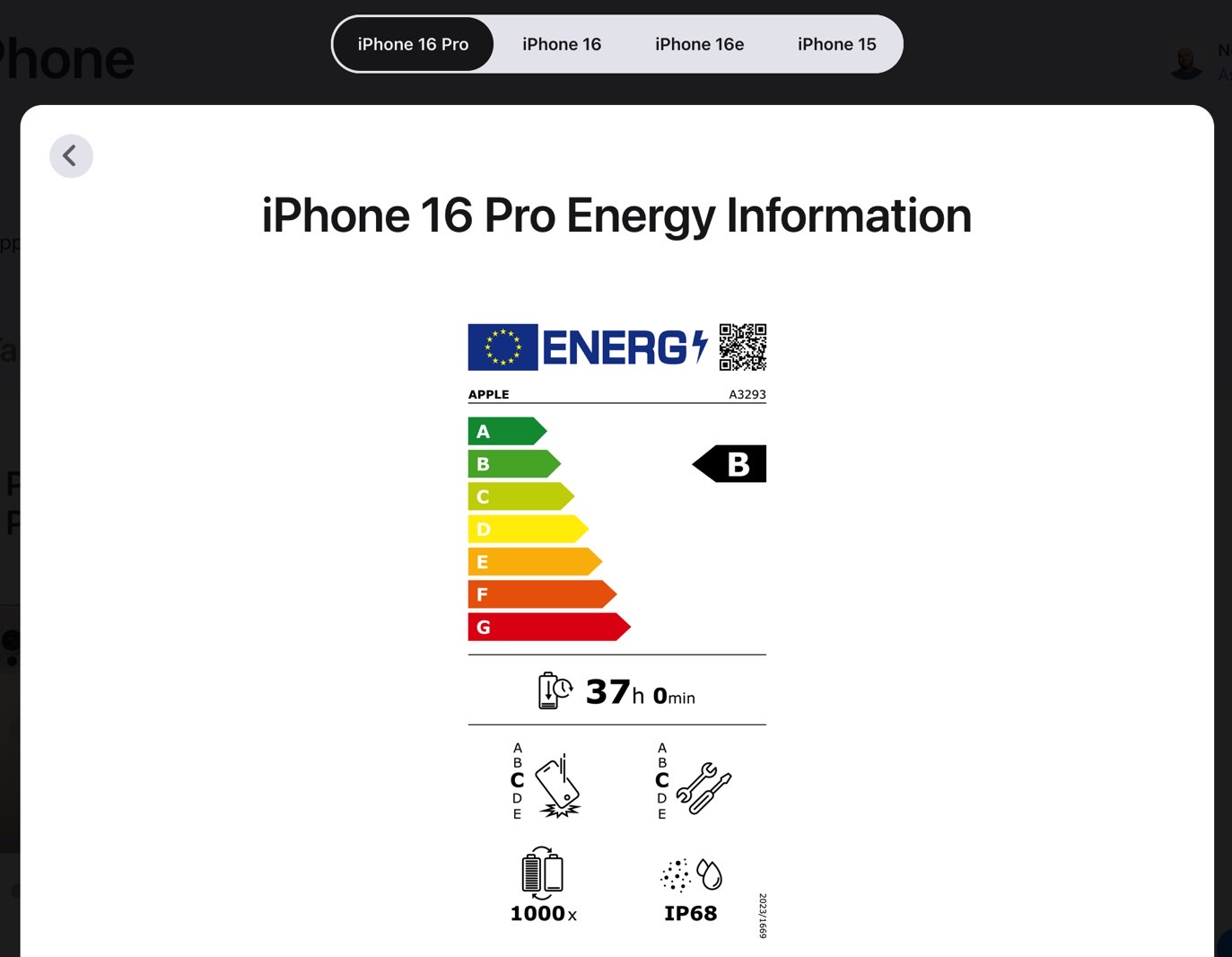We’ve known for a while that Apple would be adding energy and battery labels to the iPhone and iPad in Europe, and that moment is finally here. As a European who isn’t a fan of the EU’s Digital Markets Act (DMA) ruining the iPhone in the region, I actually don’t mind this particular initiative.
It’s not that I necessarily need to know how much electricity my iPhone and iPad consume, or how energy efficient they might be. Buy a fridge, washing machine, or big-screen TV, and that information matters. The iPhone and iPad’s energy consumption is negligible.
Still, the new energy and battery labels Apple started placing on its product pages for the iPhone and iPad in Europe reveal a few other interesting details about these devices.
The new labels are visible on Apple’s iPhone and iPad product pages, as seen below. Tap the label and you get a PDF page for each product that reveals plenty of additional details. It’s not just about how energy-efficient the iPhone and iPad are. You’ll get actual figures for battery life, battery capacity, and even years of software support.
The document tells you how the iPhone and iPad handle drops, how deep you can submerge them, and how easy they are to repair.
Apple explained in an accompanying document how it tested the iPhone and iPad. The company notes that it decided to downgrade the iPhone’s energy efficiency from an “A” to a “B” since some of the testing methods the EU offers are ambiguous.
Most iPads get a “G” rating, while the iPad mini is slightly more efficient with its “E” label.
Real battery life

Whenever Apple announces a new iPhone, it makes sure to give us battery estimates for specific activities to show that the newest iPhone can last longer than previous models. The figures aren’t necessarily accurate for real-life usage.
The new energy and battery labels finally give us better figures. Here are the battery estimates for the iPhones Apple currently sells in the EU:
- iPhone 16 Pro Max – 48 hours 0 minutes
- iPhone 16 Pro – 37 hours 0 minutes
- iPhone 16 Plus – 48 hours 0 minutes
- iPhone 16 – 37 hours 0 minutes
- iPhone 16e – 41 hours 0 minutes
- iPhone 15 Plus – 45 hours 0 minutes
- iPhone 15 – 34 hours 0 minutes
You’ll get similar figures for all the iPads in the region.
Real battery capacity
As is the case with battery life, Apple never lists the battery capacities for its iPhones. That changes in Europe, where it’s forced to show the battery capacities in the same document. They match teardowns and leaks, which is how we used to find battery capacity for each new iPhone model.
- iPhone 16 Pro Max – 4,685 mAh
- iPhone 16 Pro – 3,582 mAh
- iPhone 16 Plus – 4,674 mAh
- iPhone 16 – 3,561 mAh
- iPhone 16e – 4,005 mAh
- iPhone 15 Plus – 4,383 mAh
- iPhone 15 – 3,349 mAh
How many battery cycles are safe?
We don’t want just long battery life from the iPhone and iPad. We want the battery to last as long as possible without degrading to the point it needs replacing.
Apple’s new documents say the iPhone 16 models have a battery endurance of over 1,000 cycles. That means the battery will hold at least 80% charge for 1,000 cycles. Recharge the phone every day, and you’ll get about three years of use.
How many years of software updates does it get?
Apple routinely supports its iPhones and iPads with at least five years of new iOS updates, though it doesn’t always spell that out. The EU’s energy and battery labels now explicitly mention it. iPhones get at least five years of “operating system security updates, corrective updates and functionality updates.”
How likely is it to survive drops?

The energy and battery labels also cover durability. For example, iPhones get a “C” grade for surviving drops. “A” is best, “E” is worst. Larger iPads get an “E” rating, so try not to drop them.
How easy is it to scratch the screen?
Remember those popular durability videos that YouTube channel JerryRigEverything puts out after each new smartphone launch? One of the tests is screen hardness. The YouTuber uses various picks to see how easily the iPhone will scratch.
Now, Apple finally provides that figure. The iPhone scores a 4 on the Mohs hardness scale, which shows how scratch-resistant the display is.
What submersion depth will it survive?
Drop the iPhone in water, and it’s likely to survive. The handsets come with IP68 ratings, which means they’re resistant to drops and dust.
Apple usually highlights this during product launches, especially when it improves immersion specs. The new label documents mention the maximum immersion depth for each device. For the iPhone 16, that’s 6 meters, or about 18 feet.
The iPad doesn’t get the same IP68 rating, so don’t take it underwater.
How easy is it to repair?
Finally, the iPhone and iPad energy and battery labels confirm what we’ve long suspected. iPhones aren’t that easy to repair, with a “C” rating on the A-to-E scale. The iPad fares slightly better with a “B.”
You’ll find these new documents on all iPhone and iPad pages across Apple’s EU websites. Ireland’s Apple online store is your best bet for documentation in English, which could be handy for buyers from other markets.








